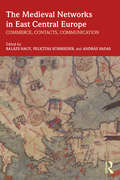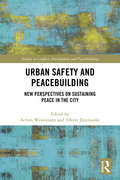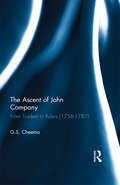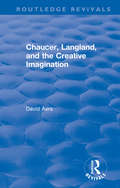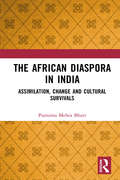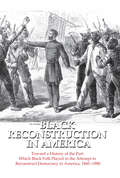- Table View
- List View
The Medieval Networks in East Central Europe: Commerce, Contacts, Communication
by Balazs Nagy András Vadas Felicitas SchmiederMedieval Networks in East Central Europe explores the economic, cultural, and religious forms of contact between East Central Europe and the surrounding world in the eight to the fifteenth century. The sixteen chapters are grouped into four thematic parts: the first deals with the problem of the region as a zone between major power centers; the second provides case studies on the economic and cultural implications of religious ties; the third addresses the problem of trade during the state formation process in the region, and the final part looks at the inter- and intraregional trade in the Late Middle Ages. Supported by an extensive range of images, tables, and maps, Medieval Networks in East Central Europe demonstrates and explores the huge significance and international influence that East Central Europe held during the medieval period and is essential reading for scholars and students wishing to understand the integral role that this region played within the processes of the Global Middle Ages.
The Medieval Networks in East Central Europe: Commerce, Contacts, Communication
by Balazs Nagy András Vadas Felicitas SchmiederMedieval Networks in East Central Europe explores the economic, cultural, and religious forms of contact between East Central Europe and the surrounding world in the eight to the fifteenth century. The sixteen chapters are grouped into four thematic parts: the first deals with the problem of the region as a zone between major power centers; the second provides case studies on the economic and cultural implications of religious ties; the third addresses the problem of trade during the state formation process in the region, and the final part looks at the inter- and intraregional trade in the Late Middle Ages. Supported by an extensive range of images, tables, and maps, Medieval Networks in East Central Europe demonstrates and explores the huge significance and international influence that East Central Europe held during the medieval period and is essential reading for scholars and students wishing to understand the integral role that this region played within the processes of the Global Middle Ages.
Urban Safety and Peacebuilding: New Perspectives on Sustaining Peace in the City (Studies in Conflict, Development and Peacebuilding)
by Achim Wennmann Oliver JütersonkeThis volume draws together original research related to conceptual and practical advances at the interface of urban safety and peacebuilding. The book reflects the advances in urban safety and peacebuilding to help address the rapidly increasing risk of conflict and insecurity in cities. Specifically, it draws on contributions to the Technical Working Group on the Confluence of Urban Safety and Peacebuilding Practice, an informal expert network co-facilitated by the United Nations Office at Geneva, UN-Habitat’s Safer Cities Programme, and the Geneva Peacebuilding Platform. A focus on ‘sustaining peace’ serves as a framework for situating new policy responses against conflict, violence, and exclusion in the city, and for promoting a conversation across disciplinary and specialist silos. The volume thereby broadens the optic of peacebuilding practice beyond interstate and intrastate armed conflicts – and especially their aftermath – and reconnects it to the community-level origins of building peace. The analysis and practice presented here will remind those willing to work towards peaceful and inclusive cities that there are tried and tested approaches available, and a host of experts and practitioners ready to accompany those prepared to lead in their respective contexts. This book will be of interest to students and researchers in the fields of peacebuilding, urban studies, security studies, and international relations.
Urban Safety and Peacebuilding: New Perspectives on Sustaining Peace in the City (Studies in Conflict, Development and Peacebuilding)
by Achim Wennmann Oliver JutersonkeThis volume draws together original research related to conceptual and practical advances at the interface of urban safety and peacebuilding. The book reflects the advances in urban safety and peacebuilding to help address the rapidly increasing risk of conflict and insecurity in cities. Specifically, it draws on contributions to the Technical Working Group on the Confluence of Urban Safety and Peacebuilding Practice, an informal expert network co-facilitated by the United Nations Office at Geneva, UN-Habitat’s Safer Cities Programme, and the Geneva Peacebuilding Platform. A focus on ‘sustaining peace’ serves as a framework for situating new policy responses against conflict, violence, and exclusion in the city, and for promoting a conversation across disciplinary and specialist silos. The volume thereby broadens the optic of peacebuilding practice beyond interstate and intrastate armed conflicts – and especially their aftermath – and reconnects it to the community-level origins of building peace. The analysis and practice presented here will remind those willing to work towards peaceful and inclusive cities that there are tried and tested approaches available, and a host of experts and practitioners ready to accompany those prepared to lead in their respective contexts. This book will be of interest to students and researchers in the fields of peacebuilding, urban studies, security studies, and international relations.
Military Medicine in Iraq and Afghanistan: A Comprehensive Review
by Ian GreavesMany, if not most, of the recent improvements in trauma care in civilian practice have developed from military experience. The British Defence Medical Services have been recognised as providers of exemplary health care. Although there will is an emphasis on trauma, this book also captures lessons from internal medicine and infectious disease, ethics (for example dealing with detainees – a particularly controversial subject), human factors, mental health issues and rehabilitation.Military Medicine provides the evidence and context for these innovations, and its unique and important account will be of interest to both military and civilian practitioners alike.
Military Medicine in Iraq and Afghanistan: A Comprehensive Review
by Ian GreavesMany, if not most, of the recent improvements in trauma care in civilian practice have developed from military experience. The British Defence Medical Services have been recognised as providers of exemplary health care. Although there will is an emphasis on trauma, this book also captures lessons from internal medicine and infectious disease, ethics (for example dealing with detainees – a particularly controversial subject), human factors, mental health issues and rehabilitation.Military Medicine provides the evidence and context for these innovations, and its unique and important account will be of interest to both military and civilian practitioners alike.
The Ascent of John Company: From Traders to Rulers (1756-1787)
by G.S. CheemaThe Ascent of John Company is the story of the founding of the British empire in India. The process of founding empires is rarely, if ever, edifying. It is invariably a sordid story of brutality and violence, tempered to some extent by blatant lies, corruption, skullduggery and intrigue. Robert Clive and Warren Hastings, the two names that come most readily to mind when one thinks of the founders, were no heroes in their times. Still less were Vansittart, Verelst, or Coote ‘Bahadur’. We have a governor who was overthrown and imprisoned by his own Councillors, and a general who had to be bribed to take the field! Many of them were accused of atrocious crimes, of murder and extortion. Bribe taking, peculation and corruption were the least of their ‘high misdemeanours’ and the most egregious were ruined by the judicial processes to which they were subjected on their return. The word nabob, which was applied to them by their own countrymen was anything but complimentary. The romanticization of the empire came much later; it was a phenomenon of the later Victorian period, but in spite of the fact that the empire has long since faded away, nostalgia for the Raj still lingers among some circles. For such people this volume will be a useful corrective; the past always seems better than the contentious present. Even for others, who may not see the past through rose tinted glasses, this book will help to place things in perspective. To paraphrase Dickens, ‘this is the best of times, and the worst of times’ – and it has always been so.
The Ascent of John Company: From Traders to Rulers (1756-1787)
by G.S. CheemaThe Ascent of John Company is the story of the founding of the British empire in India. The process of founding empires is rarely, if ever, edifying. It is invariably a sordid story of brutality and violence, tempered to some extent by blatant lies, corruption, skullduggery and intrigue. Robert Clive and Warren Hastings, the two names that come most readily to mind when one thinks of the founders, were no heroes in their times. Still less were Vansittart, Verelst, or Coote ‘Bahadur’. We have a governor who was overthrown and imprisoned by his own Councillors, and a general who had to be bribed to take the field! Many of them were accused of atrocious crimes, of murder and extortion. Bribe taking, peculation and corruption were the least of their ‘high misdemeanours’ and the most egregious were ruined by the judicial processes to which they were subjected on their return. The word nabob, which was applied to them by their own countrymen was anything but complimentary. The romanticization of the empire came much later; it was a phenomenon of the later Victorian period, but in spite of the fact that the empire has long since faded away, nostalgia for the Raj still lingers among some circles. For such people this volume will be a useful corrective; the past always seems better than the contentious present. Even for others, who may not see the past through rose tinted glasses, this book will help to place things in perspective. To paraphrase Dickens, ‘this is the best of times, and the worst of times’ – and it has always been so.
Censuses and Census Takers: A Global History (Routledge Studies in Modern History)
by Gunnar ThorvaldsenThis book analyses the international development of the census by comparing the history of census taking on all continents and in many countries. The timeframe is wide, from male censuses in the Bible to current censuses covering the whole population. There is a focus on the efforts and destinies of census takers and the development of methods used to collect information into the census questionnaires. The book highlights international cooperation in census taking, as well as how computerized access to census data facilitates genealogical studies and statistical research on both historical and contemporary societies. It deals with such questions as "Why did the French and British gentry block efforts at census taking in the 18th century?"; "What role did German censuses play during Holocaust?"; Why were the Soviet census directors executed as part of the Moscow processes?"; "Why did US states sue the Census Bureau in the 1970s?"; "How do wars and revolutions affect census taking?". The text ends by discussing whether the days of the population census as we know it are numbered, since countries exceedingly construct censuses by combining information from population registers rather than with questionnaires.
Censuses and Census Takers: A Global History (Routledge Studies in Modern History)
by Gunnar ThorvaldsenThis book analyses the international development of the census by comparing the history of census taking on all continents and in many countries. The timeframe is wide, from male censuses in the Bible to current censuses covering the whole population. There is a focus on the efforts and destinies of census takers and the development of methods used to collect information into the census questionnaires. The book highlights international cooperation in census taking, as well as how computerized access to census data facilitates genealogical studies and statistical research on both historical and contemporary societies. It deals with such questions as "Why did the French and British gentry block efforts at census taking in the 18th century?"; "What role did German censuses play during Holocaust?"; Why were the Soviet census directors executed as part of the Moscow processes?"; "Why did US states sue the Census Bureau in the 1970s?"; "How do wars and revolutions affect census taking?". The text ends by discussing whether the days of the population census as we know it are numbered, since countries exceedingly construct censuses by combining information from population registers rather than with questionnaires.
Livy's Women: Crisis, Resolution, and the Female in Rome's Foundation History
by Peter KeeganLivy’s Women explores the profound questions arising from the presence of women of influence and power in the socio-political canvas of one of the most important histories of Rome and the Roman people, Ab Urbe Condita (From the Foundation of the City). This theoretically informed study of Livy’s monumental narrative charts the fascinating links between episodes containing references to women in prominent roles and the historian’s treatment of Rome’s evolutionary foundation story. Explicitly gendered in relation to the socio-cultural contexts informing the narrative, the author’s background, the literary landscape of Livy's Rome, and the subsequent historiographical commentary, this volume offers a comprehensive, coherent and contextualised overview of all episodes in Ab Urbe Condita relating to women as agents of historical change. As well as proving invaluable insights into socio-cultural history for Classicists, Livy’s Women will also be of interest to instructors, researchers, and students of female representation in history in general.
Livy's Women: Crisis, Resolution, and the Female in Rome's Foundation History
by Peter KeeganLivy’s Women explores the profound questions arising from the presence of women of influence and power in the socio-political canvas of one of the most important histories of Rome and the Roman people, Ab Urbe Condita (From the Foundation of the City). This theoretically informed study of Livy’s monumental narrative charts the fascinating links between episodes containing references to women in prominent roles and the historian’s treatment of Rome’s evolutionary foundation story. Explicitly gendered in relation to the socio-cultural contexts informing the narrative, the author’s background, the literary landscape of Livy's Rome, and the subsequent historiographical commentary, this volume offers a comprehensive, coherent and contextualised overview of all episodes in Ab Urbe Condita relating to women as agents of historical change. As well as proving invaluable insights into socio-cultural history for Classicists, Livy’s Women will also be of interest to instructors, researchers, and students of female representation in history in general.
Routledge Revivals: Chaucer, Langland, and the Creative Imagination (Routledge Revivals)
by David AersFirst published in 1980, this study of two renowned later fourteenth century English poets, Chaucer and Langland, concentrates on some major and representative aspects of their work. Aers shows that, in contrast to the mass conventional writing of the period, which was happy to accept and propagate traditional ideologies, Chaucer and Langland were preoccupied with actual conflicts, strains, and developments in received ideologies and social practices. He demonstrates that they were genuinely exploratory, and created work which actively questioned dominant ideologies, even those which they themselves revered and hoped to affirm. For Chaucer and Langland the imagination was indeed creative, involved in the active construction of meanings, and in their poetry they grasped and explored social commitments, religious developments and many perplexing contradictions which were subverting inherited paradigms.
Routledge Revivals: Chaucer, Langland, and the Creative Imagination (Routledge Revivals)
by David AersFirst published in 1980, this study of two renowned later fourteenth century English poets, Chaucer and Langland, concentrates on some major and representative aspects of their work. Aers shows that, in contrast to the mass conventional writing of the period, which was happy to accept and propagate traditional ideologies, Chaucer and Langland were preoccupied with actual conflicts, strains, and developments in received ideologies and social practices. He demonstrates that they were genuinely exploratory, and created work which actively questioned dominant ideologies, even those which they themselves revered and hoped to affirm. For Chaucer and Langland the imagination was indeed creative, involved in the active construction of meanings, and in their poetry they grasped and explored social commitments, religious developments and many perplexing contradictions which were subverting inherited paradigms.
The Autobiography of a Revolutionary in British India
by Kali GhoshThis is a fascinating autobiography set before the partition of the subcontinent. Kali Prasad Ghosh belonged to a zamindar or landed family in Bengal. He joined the Congress movement and later, in the 1920s, became more radical. He was brought up as an intellectual but, in the end, his interest shifted to making bombs intended to blow up British property. The narrative if that of a man looking back and trying to understand his own coming to political awareness in the 1920s and 30s. Please note: Taylor & Francis does not sell or distribute the Hardback in India, Pakistan, Nepal, Bhutan, Bangladesh and Sri Lanka
The Autobiography of a Revolutionary in British India
by Kali GhoshThis is a fascinating autobiography set before the partition of the subcontinent. Kali Prasad Ghosh belonged to a zamindar or landed family in Bengal. He joined the Congress movement and later, in the 1920s, became more radical. He was brought up as an intellectual but, in the end, his interest shifted to making bombs intended to blow up British property. The narrative if that of a man looking back and trying to understand his own coming to political awareness in the 1920s and 30s. Please note: Taylor & Francis does not sell or distribute the Hardback in India, Pakistan, Nepal, Bhutan, Bangladesh and Sri Lanka
The African Diaspora in India: Assimilation, Change and Cultural Survivals
by Purnima Mehta BhattThis book explores the understudied and often overlooked subject of African presence in India. It focuses on the so-called Sidis, Siddis or Habshis who occupy a unique place in Indian history. The Sidis comprise scattered communities of people of African descent who travelled and settled along the western coast of India, mainly in Gujarat, but also in Goa, Karnataka, Andhra Pradesh, Sri Lanka and in Sindh (Pakistan) as a result of the Indian Ocean trade from the thirteenth to nineteenth centuries. The work draws from extant scholarly research and documentary sources to provide a comprehensive study of people of African descent in India and sheds new light on their experiences. By employing an interdisciplinary approach across fields of history, art, anthropology, religion, literature and oral history, it provides an analysis of their negotiations with cultural resistance, survivals and collective memory. The author examines how the Sidi communities strived to construct a distinct identity in a new homeland in a polyglot Indian society, their present status, as well as their future prospects. The book will interest those working in the fields of history, sociology and social anthropology, cultural studies, international relations, and migration and diaspora studies.
The African Diaspora in India: Assimilation, Change and Cultural Survivals
by Purnima Mehta BhattThis book explores the understudied and often overlooked subject of African presence in India. It focuses on the so-called Sidis, Siddis or Habshis who occupy a unique place in Indian history. The Sidis comprise scattered communities of people of African descent who travelled and settled along the western coast of India, mainly in Gujarat, but also in Goa, Karnataka, Andhra Pradesh, Sri Lanka and in Sindh (Pakistan) as a result of the Indian Ocean trade from the thirteenth to nineteenth centuries. The work draws from extant scholarly research and documentary sources to provide a comprehensive study of people of African descent in India and sheds new light on their experiences. By employing an interdisciplinary approach across fields of history, art, anthropology, religion, literature and oral history, it provides an analysis of their negotiations with cultural resistance, survivals and collective memory. The author examines how the Sidi communities strived to construct a distinct identity in a new homeland in a polyglot Indian society, their present status, as well as their future prospects. The book will interest those working in the fields of history, sociology and social anthropology, cultural studies, international relations, and migration and diaspora studies.
A History of Crime and the American Criminal Justice System
by Mitchel P. RothThis book offers a history of crime and the criminal justice system in America, written particularly for students of criminal justice and those interested in the history of crime and punishment. It follows the evolution of the criminal justice system chronologically and, when necessary, offers parallels between related criminal justice issues in different historical eras. From its antecedents in England to revolutionary times, to the American Civil War, right through the twentieth century to the age of terrorism, this book combines a wealth of resources with keen historical judgement to offer a fascinating account of the development of criminal justice in America. A new chapter brings the story up to date, looking at criminal justice through the Obama era and the early days of the Trump administration. Each chapter is broken down into four crucial components related to the American criminal justice system from the historical perspective: lawmakers and the judiciary; law enforcement; corrections; and crime and punishment. A range of pedagogical features, including timelines of key events, learning objectives, critical thinking questions and sources, as well as a full glossary of key terms and a Who’s Who in Criminal Justice History, ensures that readers are well-equipped to navigate the immense body of knowledge related to criminal justice history. Essential reading for Criminal Justice majors and historians alike, this book will be a fascinating text for anyone interested in the development of the American criminal justice system from ancient times to the present day.
A History of Crime and the American Criminal Justice System
by Mitchel P. RothThis book offers a history of crime and the criminal justice system in America, written particularly for students of criminal justice and those interested in the history of crime and punishment. It follows the evolution of the criminal justice system chronologically and, when necessary, offers parallels between related criminal justice issues in different historical eras. From its antecedents in England to revolutionary times, to the American Civil War, right through the twentieth century to the age of terrorism, this book combines a wealth of resources with keen historical judgement to offer a fascinating account of the development of criminal justice in America. A new chapter brings the story up to date, looking at criminal justice through the Obama era and the early days of the Trump administration. Each chapter is broken down into four crucial components related to the American criminal justice system from the historical perspective: lawmakers and the judiciary; law enforcement; corrections; and crime and punishment. A range of pedagogical features, including timelines of key events, learning objectives, critical thinking questions and sources, as well as a full glossary of key terms and a Who’s Who in Criminal Justice History, ensures that readers are well-equipped to navigate the immense body of knowledge related to criminal justice history. Essential reading for Criminal Justice majors and historians alike, this book will be a fascinating text for anyone interested in the development of the American criminal justice system from ancient times to the present day.
Rediscovering Renaissance Witchcraft
by Marion GibsonRediscovering Renaissance Witchcraft is an exploration of witchcraft in the literature of Britain and America from the 16th and 17th centuries through to the present day. As well as the themes of history and literature (politics and war, genre and intertextuality), the book considers issues of national identity, gender and sexuality, race and empire, and more. The complex fascination with witchcraft through the ages is investigated, and the importance of witches in the real world and in fiction is analysed. The book begins with a chapter dedicated to the stories and records of witchcraft in the Renaissance and up until the English Civil War, such as the North Berwick witches and the work of the ‘Witch Finder Generall’ Matthew Hopkins. The significance of these accounts in shaping future literature is then presented through the examination of extracts from key texts, such as Shakespeare’s Macbeth and Middleton’s The Witch, among others. In the second half of the book, the focus shifts to a consideration of the Romantic rediscovery of Renaissance witchcraft in the eighteenth century, and its further reinvention and continued presence throughout the nineteenth, twentieth and twenty-first centuries, including the establishment of witchcraft studies as a subject in its own right, the impact of the First World War and end of the British Empire on witchcraft fiction, the legacy of the North Berwick, Hopkins and Salem witch trials, and the position of witchcraft in culture, including filmic and televisual culture, today. Equipped with an extensive list of primary and secondary sources, Rediscovering Renaissance Witchcraft is essential reading for all students of witchcraft in modern British and American culture and early modern history and literature.
Rediscovering Renaissance Witchcraft
by Marion GibsonRediscovering Renaissance Witchcraft is an exploration of witchcraft in the literature of Britain and America from the 16th and 17th centuries through to the present day. As well as the themes of history and literature (politics and war, genre and intertextuality), the book considers issues of national identity, gender and sexuality, race and empire, and more. The complex fascination with witchcraft through the ages is investigated, and the importance of witches in the real world and in fiction is analysed. The book begins with a chapter dedicated to the stories and records of witchcraft in the Renaissance and up until the English Civil War, such as the North Berwick witches and the work of the ‘Witch Finder Generall’ Matthew Hopkins. The significance of these accounts in shaping future literature is then presented through the examination of extracts from key texts, such as Shakespeare’s Macbeth and Middleton’s The Witch, among others. In the second half of the book, the focus shifts to a consideration of the Romantic rediscovery of Renaissance witchcraft in the eighteenth century, and its further reinvention and continued presence throughout the nineteenth, twentieth and twenty-first centuries, including the establishment of witchcraft studies as a subject in its own right, the impact of the First World War and end of the British Empire on witchcraft fiction, the legacy of the North Berwick, Hopkins and Salem witch trials, and the position of witchcraft in culture, including filmic and televisual culture, today. Equipped with an extensive list of primary and secondary sources, Rediscovering Renaissance Witchcraft is essential reading for all students of witchcraft in modern British and American culture and early modern history and literature.
The Hieroglyphics of Horapollo Nilous: Hieroglyphic Semantics in Late Antiquity (Issues in Ancient Philosophy)
by Mark WildishThe main aim of this book is to reconstruct a philosophical context for the Hieroglyphica of Horapollo, a late 5th century Greek study of hieroglyphic writing. In addition to reviewing and drawing on earlier approaches it explores the range of signs and meanings for which Horapollo is interested in giving explanations, whether there are characteristic types of explanations given, what conception of language in general and of hieroglyphic Egyptian in particular the explanations of the meanings of the glyphs presuppose, and what explicit indications there are of having been informed or influenced by philosophical theories of meaning, signs, and interpretation.
The Hieroglyphics of Horapollo Nilous: Hieroglyphic Semantics in Late Antiquity (Issues in Ancient Philosophy)
by Mark WildishThe main aim of this book is to reconstruct a philosophical context for the Hieroglyphica of Horapollo, a late 5th century Greek study of hieroglyphic writing. In addition to reviewing and drawing on earlier approaches it explores the range of signs and meanings for which Horapollo is interested in giving explanations, whether there are characteristic types of explanations given, what conception of language in general and of hieroglyphic Egyptian in particular the explanations of the meanings of the glyphs presuppose, and what explicit indications there are of having been informed or influenced by philosophical theories of meaning, signs, and interpretation.
Black Reconstruction in America: Toward a History of the Part Which Black Folk Played in the Attempt to Reconstruct Democracy in America, 1860-1880
by W. E. B. Du BoisAfter four centuries of bondage, the nineteenth century marked the long-awaited release of millions of black slaves. Subsequently, these former slaves attempted to reconstruct the basis of American democracy. W. E. B. Du Bois, one of the greatest intellectual leaders in United States history, evaluates the twenty years of fateful history that followed the Civil War, with special reference to the efforts and experiences of African Americans.Du Bois's words best indicate the broader parameters of his work: "the attitude of any person toward this book will be distinctly influenced by his theories of the Negro race. If he believes that the Negro in America and in general is an average and ordinary human being, who under given environment develops like other human beings, then he will read this story and judge it by the facts adduced."The plight of the white working class throughout the world is directly traceable to American slavery, on which modern commerce and industry was founded, Du Bois argues. Moreover, the resulting color caste was adopted, forwarded, and approved by white labor, and resulted in the subordination of colored labor throughout the world. As a result, the majority of the world's laborers became part of a system of industry that destroyed democracy and led to World War I and the Great Depression. This book tells that story.
